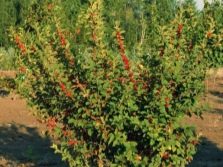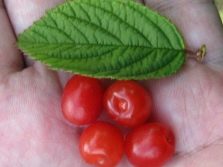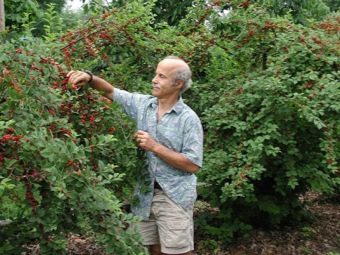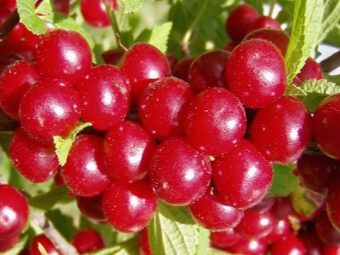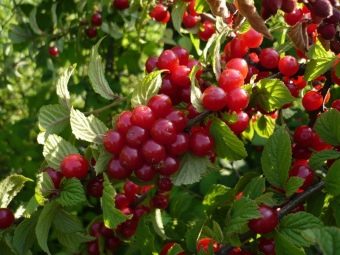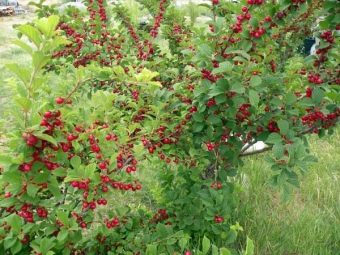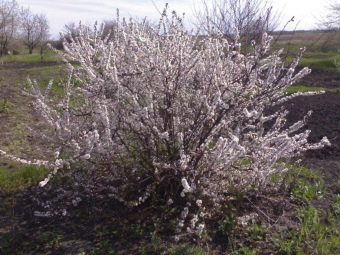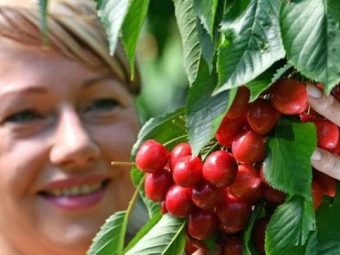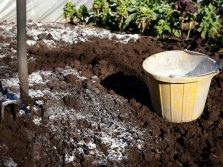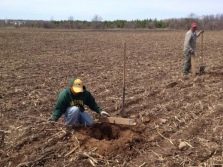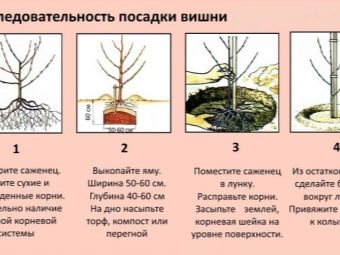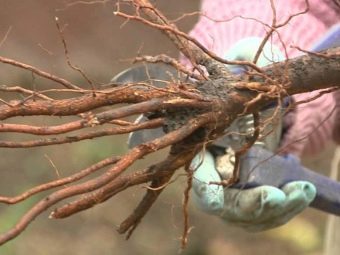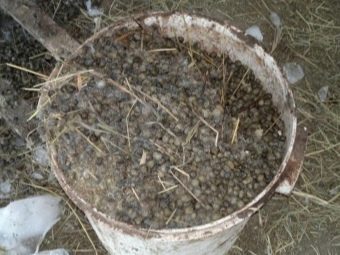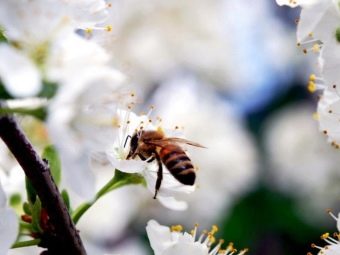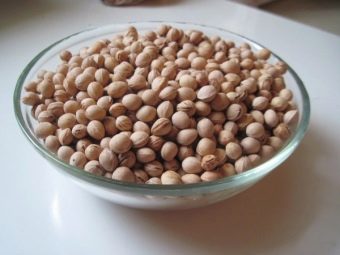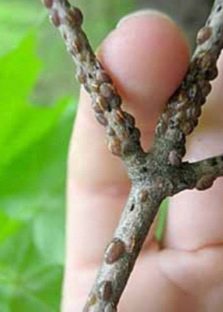Cherry felt: description, varieties and secrets of cultivation
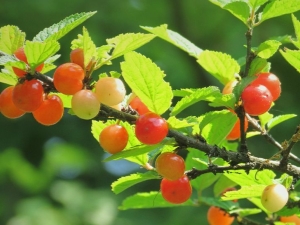
Cherry felt appeared in the Far East, somewhere in the Himalayan region or Japan.Due to the natural adaptability of the plant to rather extreme conditions, as well as an attractive appearance, it is chosen for growing by many Russian gardeners.
Characteristic
Felt cherry - one of the most common plants found in areas of amateur gardeners. It is not only a fruit and berry crop, but also serves to decorate the garden in the spring. It is no secret that cherry blossom is one of the most beautiful natural phenomena. Felt cherry, which differs from the classical form only, also blooms beautifully, exuding a wonderful aroma.
It is necessary to explain why the cherry is called felt. The thing is that on the stems, leaves, and even the berries themselves there is a small soft fluff. On the fruits it is little pronounced, but on the leaves immediately noticeable. Do not be afraid - it is not a disease, just a feature of the plant.
Felt cherry is great for use as a "live" fences. Some shrubs have a thick crown, through which you can not see what is happening on the site. In addition, the areas under the fence are usually open and illuminated, which is just suitable for growing this crop.
The main disadvantage is the fact that the life of a felt cherry is relatively short. If you do not care for it properly, it will grow and bear fruit for 10-15 years, however, if you devote enough time and energy to caring for the plant, it will live much longer - up to 20 years.
When do you bear fruit?
Fruiting of the overwhelming majority of varieties occurs in the second half of July. The average duration of the formation of the fruit - 10 days. Flowering begins in the 15-20 of May.
The time of fruiting and the abundance of the harvest depends largely on the conditions in which cherry felts grow, as well as on the variety. Early ripening varieties, on average, yield 1.5 weeks earlier than the middle ripening. Plays an important role and climate. Small spring frosts will not have a significant impact on the period of fruiting, but strong cold frosts or gusty winter wind can significantly reduce yields.
On average, a felt cherry begins to bear fruit for 2-3 years after planting in open ground. During this period, from one shrub you can get from 200 g to 600 g yield. A full crop can be harvested for 3-4 years, while it will grow significantly and will be from 6 kg to 14 kg, depending on the variety. A great influence on the yield has the quality of care, as well as timely feeding of the plant.
Sorta
Today, amateur gardeners have a huge list of various types of felt cherries. Most of them appeared in the last century, but this does not prevent them from being loved until now. The thing is that hybrid cultures are ideally adapted to Russian realities. In many regions, strong frosts and unstable climate, so the plants must be adapted to any turn of events.
In addition, the most popular varieties of felt cherries have a spectacular appearance not only of shrubs, but also of fruits. The vast majority have an appetizing red color, the intensity of which varies greatly. Also, gardeners and gardeners love most of all to grow large-fruited varieties, so not a single variety with small berries is found among the popular ones.
Please note that for some varieties special conditions are important, for example, large amounts of sunshine or moderate humidity. It is strongly recommended to take these nuances into account, since the volumes and quality of the crop depend on the degree of fulfillment of these conditions.
So, we offer you the most common varieties. Judging by the reviews, they are the best among all varieties of cherry felt.
"Natalie"
Cherry felt "Natali" is one of the most popular.It is chosen by many gardeners and gardeners due to the many advantages. So, the Natali variety is suitable not only for cultivation as a fruit crop, but also simply for decoration. However, the crop that can be harvested is also quite impressive.
Cherry "Natalie" is perfect for breeding in the Russian realities with harsh winters. This species tolerates frost well, so that it can be grown even in Siberia. Despite the cold, the crop can be obtained on average 10 days earlier than when growing ordinary cherry, and it is easier to remove it due to the fact that cherry felt “Natali” is a shrub.
Variety "Natalie" is quite high when compared with other varieties. In the height of the bushes reach two meters. The crown is spreading, while not thick, due to which excellent ventilation is maintained. The berries are large, rich burgundy. The skin is covered with hairs. As for taste, they are rated as above average.
When choosing a place for planting, it should be noted that a large amount of sun is important for cherry felt “Natali”. Choose the sunniest plot. It is also necessary that the groundwater was not very deep, and the plant could reach them with roots. In the reverse situation, the harvest and its quality will be very different from the desired.
"Princess"
The grade "Tsarevna" is often chosen by summer residents and gardeners by virtue of magnificent decorative properties. However, it is important to clarify one nuance inherent in this species. It lies in the fact that the "Princess" - not quite a cherry in the traditional sense. It belongs to the plum tree, therefore it is impossible to cross it with a cherry.
Cherry felt "Tsarevna" has several advantages. One of them - high frost-resistant qualities, so it can be bred in Siberia, and in the Urals, and in the suburbs. It is also noteworthy that the berries contain a large amount of minerals and vitamins, so they are good for health. According to the taste characteristics, the fruits of the "Princess" are also not inferior to their counterparts. Gardeners celebrate great taste and rich aroma of tart. Cherry begins to bear fruit early, while the crops are always abundant. In addition, the variety is resistant to certain diseases, such as coccomycosis.
Shrub in height rarely reaches one and a half meters. The average height is 1.2 m. The crown is spreading, but not very thick. The most attractive cherry "Tsarevna" looks during flowering. All branches are covered with white flowers, which emit a strong fragrance.
As for the fruits, they are large. In weight cherry reaches 4 grams. The form is also atypical. Here the berries are not round, but oval. Peel has a pink tint. The flesh is slightly acidic, but it does not spoil the taste. It should be borne in mind that although the flesh is thick, it is impossible to transport cherries.
It deteriorates quickly, so it is advisable to use it immediately after collection.
"Spark"
This variety was bred in the Khabarovsk Territory in the distant 1958, and since then has not lost its relevance. Summer residents are still choosing the "Spark" for a number of advantages inherent in this class. Among them frost resistance, pleasant taste of berries, magnificent decorative qualities.
Cherry "Spark" begins to bear fruit for 2-3 years after planting. The period of fruiting depends on the quality of care and can reach 20 years. In height, the shrub can reach 2.5 m. The crown is spreading, of medium density. The diameter of the crown can be up to 1.8 m.
The berries are large, fragrant, in weight can be up to 4 grams. The sugar content in fruits can reach 12%, which speaks of the moderate sweetness of Sparkly Cherry. The skin color is bright red, without pink. It is believed that because of such bright fruits, the variety got its name.
When choosing a place for landing, it is important to consider that the “Spark” variety does not tolerate drought, so care must be taken to ensure that the groundwater does not run very deep. In the case when it is impossible to choose such a place, take care of regular watering of the plant. Also, it will need to be watered plentifully during fruiting, as the fruits become shriveled due to lack of moisture, losing their aesthetic appearance.
If in winter the temperature of the air in your region falls below -25 degrees, then you need to warm the felt “Spark” cherry. Experienced gardeners are advised to use sheets of slate, and not cellophane film.
"Alice"
Homeland grade "Alice" is Primorsky Krai. Sprawling shrub with a dense crown. It reaches a height of one and a half meters. Variety "Alice" is valued primarily for its decorative properties. Thick bushes of felt cherries of this variety are often used as a hedge.
Berries are not the largest. Their weight is on average equal to 3.3 grams. The shape of the fruit is ellipsoid, slightly elongated. The color is saturated burgundy, and the flesh is bright red. As for taste, they are slightly lower than the previous two varieties. They are estimated only at 4 points out of 5. Because of this, the berries are more suitable for processing than for consumption. They make delicious jam, marmalade, wine.
Despite the fact that the berries are quite dense, problems may arise with their collection and transportation. Fruits of the Alice cherry are easily damaged, therefore they cannot be picked up mechanically. Also, they are practically not stored.
Please note that if you do not harvest on time, you can achieve shredding of fruits. As a result, they will become too small, so that the labor expended on their collection will not be comparable to the value.
Among other things, the variety is prone to moniliosis, as the shrub is thick and the berries are tightly attached to each other. In this regard, it is necessary to make sufficient efforts to thin the crown and prevent the appearance of the disease.
"Fairy tale"
Felt cherry varieties "Fairy Tale", like the others, has an aesthetic appearance. The crown is medium-sized, has an oval shape, which looks especially harmonious with timely pruning. Remarkably, it is low perennial. The cherry tale shrub reaches a height of only 1.3 m.
Berries grow large - up to 3.5 grams each. The fruits clearly visible abdominal suture. The color of the skin and flesh is burgundy, the juice is also reddish. The taste of the berries is slightly acidic, but sour is harmoniously combined with sweetness. The taste is mediocre. It is estimated at 3.8 points out of 5. Nevertheless, the berries can be eaten both raw and processed, making jam, marshmallow and others.
Variety "Fairy Tale" is different in that you can get a high yield from it. Up to 10 kg of fruits can be harvested from each shrub, but this figure drops sharply if improper care is taken behind the plant. What is remarkable Felt cherry "Fairy Tale" not only tolerates cold, but also drought. On the contrary, too frequent watering for it is destructive. In damp soil, roots can rot.
This variety is suitable not only for amateur breeding, but also for professional.
The only caveat is that it cannot be mechanically collected, because, firstly, the fruits are too tight, and secondly, too much pressure will damage the berries.
"Delight"
Shrubs varieties "Delight" grow low - up to 1.5 meters. At the same time, the crown is spreading and thick, so that it requires constant care: timely cutting, thinning, shaping.
The variety was named in this way because of the taste of the fruit, which is rated at 4 points out of 5. The berries themselves are large, of a rich red color, with a clearly visible side seam. They are used mainly in raw form, but they are also suitable for processing: cooking compotes, making juices.
Variety "Delight" - one of the few that can be transported. Berries in case of careful transportation will not lose their external attractiveness, but transportation for too long distances will not withstand. Storage fruits are not subject. They immediately need to be processed or eaten.
Up to 9.2 kg of crop can be harvested from each bush of Delight cherry, which is quite a lot. Like the previous species, "Delight" is drought tolerant and does not tolerate excessive moisture. The variety is frost resistant, therefore suitable for the Moscow region, Siberia, the Urals. To grow such a crop is possible not only in amateur farms, but also on farms and horticultural enterprises. A large fruit is convenient to collect even by hand.
"East"
Cherry shrubs of the Vostochnaya felt variety are among the most compact. They reach a height of 1.5 meters, while the crown is average spreading, and the bush itself is of medium thickness. Flowers, and behind them, and berries, are scattered in all branches, and not concentrated only at the ends.
The fruits are not very large - up to 3.3 grams. The berries are red-maroon, and the abdominal seam is practically not visible on them. Red dense pulp has a pleasant taste, which was rated at 4 out of 5 points. The combination of acid and sweetness feels harmonious. As for the appearance, the berries look spectacular and attractive.
You can make jam, jam, juice or something else from Oriental cherry, or you can consume it raw. It is important to process or eat cherries immediately, as it is stored for only a short time. You can transport it, but with extreme caution.
Remarkably, the Vostochnaya cherry starts fruiting for 2 years after planting, giving a yield of up to 8.7 kg from a bush. In this small spring frosts are not afraid of flowers. Variety tolerates frost.
However, this species is not resistant to drought or excessive moisture. In the first case, the fruits will become skukozhennymi and lose juiciness, in the second - will be affected by moniliasis.
"Children"
The tall shrub of the Nursery variety immediately attracts attention due to its spectacular appearance. The height of the cherry of this variety reaches 1.8 m. At the same time, the spreading crown is not very thick, which is why the Feline Fungal Cherry is resistant to several diseases.
The berries are large and reach 4 grams in bulk. Bright red skin has hairs on the surface. It is noteworthy that the bones in the fruit are very small and make up no more than 0.4% of the total weight of the berry. The taste of the berries are pleasant and harmonious, with a little sourness. Evaluation of taste - 3.9 points out of 5. With regard to the use in food, then the berries can be both cooked and eat fresh. To transport a crop it is necessary with extreme care.
Up to 10 kg of cherries can be harvested from each bush, so the mechanized method cannot be used. The skin on the fruit is too thin, its integrity will be broken. Berry storage is also not subject to - quickly deteriorate due to juiciness.
The variety “Children's” perfectly tolerates frost and drought, while it is impossible to prevent excessive soil moisture. This will lead not only to the decay of the roots, but also to the defeat of the fruits of moniliosis. Also note that it is necessary to harvest the crop as soon as it is ripe. Otherwise, the fruits become noticeably smaller.
"Beauty"
The dense bush of cherry felt variety "Beauty" reaches a height of 1.6 m. Crohn spreading. It must be regularly thinned, give it shape. Like other varieties, “Beauty” is prone to the occurrence of moniliosis due to too tight fit of the fruit, so overmoistening is disastrously contraindicated
The maximum mass of berries is 3.5 grams, while the inside of the bone is large. Its weight is 5.3% of the total mass of the fetus. The variety got its name due to the spectacular appearance of the berries. Cherry dark pink color, the hairs on the skin is almost invisible. The taste of the berries is pleasant. He was rated at 3.8 points out of 5.Due to the high taste qualities of the berries can be consumed in raw and processed form.
The variety has an extremely high yield. So, from each bush you can collect up to 10.7 kg. Please note that mechanical harvesting is not possible. Also the grade does not tolerate transportation and cannot be stored. Because of this, it must be grown in farms, next to which there are processing points or enterprises. Also, cherry “Beauty” is grown by amateur gardeners.
Cherry is resistant to frost and drought. The crop needs to be removed as soon as it is ready. First, so you can achieve maximum yield. Secondly, the fruits do not have time to shred due to overload.
"Ocean virovskaya"
The variety "Ocean virovskaya" is perfect for breeding for ornamental purposes. Tall and not sprawling shrub looks attractive and delicate. In height cherry felted "Ocean virovskaya" reaches 1.8 m. The bush is of medium thickness, therefore it is less susceptible to diseases due to the fit of the fruits to each other.
The fruits have a mouth-watering appearance. They are burgundy colored, the hairs on the skin are almost invisible. The flesh has a light odor that emphasizes the sour taste in a special way. Bones in the fruit are large. They make up 6% by weight. Tastes are rated at 4 out of 5 points. It is mainly recommended to use fresh cherries because of the excellent taste and aroma, but it is also used to make compotes, make jam and make jam.
Up to 9 kg of yield can be obtained from each bush, however, in order to achieve maximum yield, it is necessary to collect ripe fruits in time. Otherwise, they are crushed. The plant is well adapted to frost and cooling, drought, but does not tolerate high soil moisture.
The fruits begin to ripen in the 20th of July. You can wait for the first harvest in the second year after planting seedlings in the ground, in the maximum yield - for 4 years. The variety is well suited for amateur breeding.
"Pink fruit"
This variety is not valued for its decorative qualities, but for its high yield. Despite the fact that the shrub is low, each can get up to 9.6 kg of cherries. It is worth saying that the bush itself is sprawling, which also plays a significant role.
Fruit weight is 3 grams. In this case, the berries can not be called attractive or spectacular. Due to the fact that they have a pink color, it seems to many that the fruits are immature, but it is not. The unsightly appearance does not affect the taste characteristics of cherries. Their rating is 4 points out of 5. Sour-sweet fruits have no pronounced aroma.
Unfortunately, this variety does not tolerate freezing, so it is not suitable for planting in regions with cold winters. Cherry "Pink fruitful" moderately tolerates drought and excessive moisture, so you should monitor the condition of the shrub.
As you can see, there are quite a lot of popular varieties with high yields and pleasant cherry flavors. You just have to make a choice, paying particular attention to the condition of the soil on your site.
Keep in mind that not all species require high groundwater levels. For some of them, this neighborhood is even undesirable. Be sure to focus not only on the appearance and quality of the berries, but also on the relevance of growing this particular variety in the existing conditions.
Growing conditions
For the most part, felt cherries prefer light and loose soils rich in nutrients. This may be black earth, loam or sandy varieties. Good soil drainage is important so that the roots can germinate freely. You should not plant felted cherries in peaty or marshy ground, as this will negatively affect the general condition of the plant, its ability to produce crops.
Also check the soil pH balance. The soil should be neutral.Excessively acidic soils need to lime, and neutralize the high content of alkalis with acid.
Consider that the quality of the soil is directly related to the quality and taste of the fruit, so take the time to tillage.
It is important that the felt cherry area is well lit. The presence of direct sunlight is a decisive factor for the successful cultivation of this crop. First, it will lead to more rapid evaporation of moisture. Consequently, it will be possible to avoid waterlogging of the soil under the shrub. Secondly, with constant exposure to sunlight, the formation of flowers and fruit set will be faster.
What is remarkable, in the same place you need to plant not only one sapling of one variety, but several at once. It is advisable to choose at least three varieties. Cross-pollination will make the quality of the crop an order of magnitude higher, and in some cases will ensure that the shrub begins to bear fruit. The fact is that for some varieties self-fertility is impossible, or it occurs only 3-4 years after planting.
Landing
Before planting felt cherries, it is necessary to become familiar with the requirements that this process must meet. First of all, you need to make a reservation that planting should be done in the warm season. Then the higher the likelihood that they take root, consolidate and gain strength. Optimally plant felted cherry either in spring before bud breaks, or until September inclusive.
It is best to plant young plants on high ground, which should be protected from gusty winds. In addition, the melting snow will not accumulate in such places, respectively, seedlings will not be exposed to the negative effects of high humidity.
If it turned out that you purchased a sapling after all the terms of disembarkation (for example, late autumn), then you may well leave it for wintering in the basement, as long as you keep warm. In the spring you will need to carefully inspect the plant, cut off the roots and dried parts. Only after that it will be possible to start landing in open ground.
Selection of seedlings
The first thing that an experienced gardener thinks about when he decides to plant a crop on his plot is how to choose a sapling so that it will be of high quality, take root and give a quick harvest. There are several criteria that you should pay attention to when buying.
- The height of a felt sapling cherry should be about 1 m. It should consist not of one stem, but of a trunk with branches.
- The root system must also be developed. The length of the roots can reach 30 cm.
- Pay attention to the general appearance of the young plant. If it seems to you that it has traces of pests or diseases, most likely it is. Do not listen to the assurances of the seller that you thought. Better not to risk it.
- It so happens that recognizing the quality of a seedling is not so easy. At first glance, it may seem dead, but in fact just a little cold. Then it is recommended to conduct a small test. Hard bark on the seedling is a little scratched. If a healthy green live bark is found under it, then the seedling is also suitable. If everything is dry, then the plant is dead and not suitable for planting.
In conclusion, it should be said that the sapling needs to be bought only from a trusted supplier. Buying a plant with it is not the best solution.
Planting process
To plant the seedling properly, Use the following instruction.
- Dig a hole 40-50 cm deep. The diameter should be 60-70 cm.
- Prepare a sapling. The first step is to trim the root system. After pruning, the length of the roots should be no more than 20 cm. After that, rinse the roots in a clay-water solution. This will allow them to settle down faster.
- Place the plant in a previously dug hole, placing in it only the roots, but not the root neck. Then fill the hole with earth mixed with cherry fertilizer.They can be purchased at a gardening shop.
- Water well, then sprinkle with mulch. It can be made from spruce chips or peat. Do the same for all the seedlings.
Please note that the distance between them should not exceed three meters. This guarantees the optimal conditions necessary for the full development of all three plants, including their cross-pollination.
As you can see, it is not so difficult to plant the felt cherries. The main thing is good preparation.
Care
Top dressing
The following fertilizers are recommended for feeding:
- manure;
- lime;
- phosphorus;
- potassium.
All of these components need to be mixed in a ratio of 3000/600/50/25 g, then add to the soil under the shrub. This dressing can be used at the time of planting cherry felt instead of purchased fertilizer. It will serve as well.
Among other things, it is necessary to feed the plant after flowering. In this case, fertilizers are applied in the following proportions:
- manure - 6 kg;
- potash - 20 g;
- nitrogen - 30 g;
- phosphoric - 70 g.
Make the feeding should be on the edges of the pristvolny circles.
Once every five years resorted to the liming of the soil. To do this, you can use wood ash.
It is also important to attract pollinating insects. Without proper pollination, it will not be possible to achieve good tasty yields. These insects include bees, bumblebees, some flies, beetles, and others.
Pruning
Growing felt cherries requires some effort, which is to properly trim and thin the crown, preparing the plant for the summer. So, it should be borne in mind that all work on pruning should be carried out strictly before the appearance of the kidneys. Otherwise you will do more harm than help.
Cut the plant should be immediately after it was planted. The first step is to form the skeleton of the future shrub. To do this, the young sapling pruned some branches that grow higher than half a meter from the ground level. In this case, the central and highest branch will become a kind of trunk. Shorten the branches need 17-20 cm depending on the initial length.
The next couple of years, it is necessary to thin out the crown, cutting unsuccessfully growing branches. These include those that grow inward, intertwine with each other. This procedure is due to the fact that for the formation of the kidneys need light, and in places with a large cluster of branches it will not break through.
At 5-6 year can already be limited to simple procedures to maintain the beautiful shape of the crown.
Shelter for the winter
There is no urgent need to cover the bushes of felt cherries for the winter. Exceptional are the cases when it comes to regions in which temperatures in winter fall below -40 degrees. Most varieties are able to cope with frost down to -40 degrees, otherwise you will need to work hard.
It is not recommended to use ordinary polyethylene film as a heater. There is little sense from it, but thus the usual microclimate and ventilation will be broken. Much better to use slate sheets. They will protect not only from the cold, but also from the gusting wind. Ensure that slate sheets are well reinforced. If they fall, they can pin down the shrubs themselves.
After hard colds, it is recommended to examine the plants for frozen branches, and remove them during spring pruning.
Breeding methods
In total, there are two methods of reproduction of felt cherries: seeds and cuttings. The first option is simpler and more understandable, however, it is used quite rarely due to its specificity. So, in order to achieve fruiting, it is necessary to use cross-pollination with enviable regularity, and it’s not a fact that the plant will ever produce a crop. In the future, it will need to instill.
Quite another thing - reproduction by cuttings. In this case, you do not need to wait until the seed germinates and gives more or less viable shoots.To multiply the plant in a similar way, you need to cut off the shoots in July - just at the time of its fruiting. For this, it is necessary to pinch a sprout 15 cm long from a branch of 2-3 orders of magnitude. Pay attention to the presence of wood. It should be on the handle, at least a couple of centimeters.
After the necessary stalk is obtained, it must be kept in the growth regulator solution for a third of the day, and then planted in the ground. It is necessary that the bark is completely in the ground. You also need to bury about a centimeter of the green part.
Next, the planted shoots are covered with a film, preferably matte, to prevent exposure to too bright sunlight. Cuttings need to be watered all the time, make sure that the soil under them is moderately wet. After 4 weeks, they will acquire their own full-fledged root system.
Diseases and pests
Cherry felt is considered one of the most unpretentious plants that are resistant to all kinds of viruses and pests. However, there are a number of diseases to which it is exposed. The most common of these is monilioz. A clear signal that the cherry is sick is the poor condition of the branches: they dry.
Unfortunately, there is no effective way to combat monoliosis. The only thing that can be done is to pre-treat the plant with a half-percent solution of copper sulfate for prevention. It is also necessary to regularly thin out the crown, avoiding stagnant moisture. If you notice signs of disease on the branches, they must be cut off.
As for pests, most often the shrubs of felt cherries are struck by scab. The fight against it is extremely difficult due to the fact that this insect is not so easy to calculate. Outwardly, it looks like ordinary growths on a plant. Treatment involves first the mechanical removal of adult insects, and after - treatment with the insecticide "Aktellik".
Please note that when you remove the scythes, it is necessary to scrape it, as the shell practically grows to the shoots.
In order to prevent damage to the plant by mice, use ordinary fine-meshed iron mesh. It is wound on the trunk of a bush in several layers to protect against mouse teeth. Check the integrity of the grid should be year-round. Mice are active not only in summer, but also in winter, and a layer of snow cannot save the plant from their raids.
How to care for felt cherries, see the next video.

